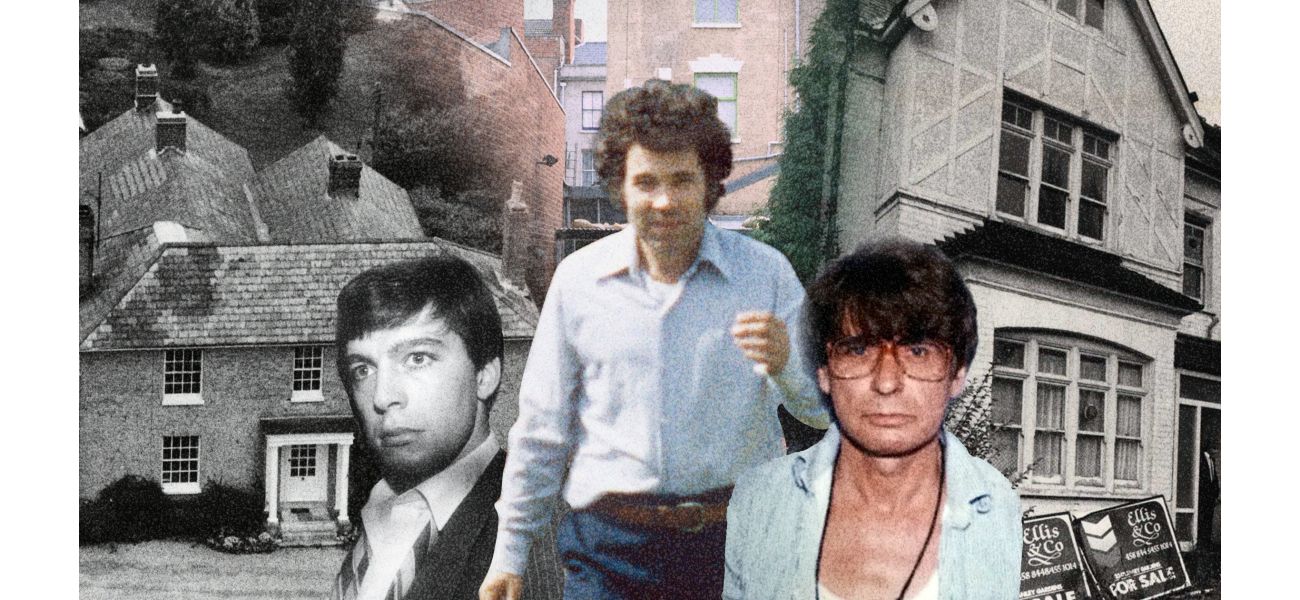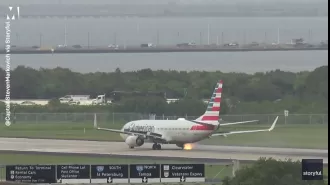Explore the eerie and terrifying secrets hidden within the infamous "murder houses" of Britain.
Buyers were advised to look into the property's background before purchasing it.
September 9th 2024.

Throughout the UK, there are homes that hold a dark and gruesome history. These are the places where infamous murderers like Jeffrey Bamber, Fred West, and Dennis Nilsen took the lives of their victims. Some of these properties have been remodeled or torn down, while others remain standing as a physical reminder of the horrors that occurred within their walls.
Take, for example, the cozy flat in Wales where a man was brutally killed with a stone frog, the family home in England where a kind landlady was attacked with an axe, and the ancient castle in Scotland where a noble lord met his demise. These are just a few of the so-called "murder houses" scattered across the UK.
But how can one know if they are living in a "murder house"? It's not common for these properties to be torn down. In fact, more often than not, the crime scene is simply cleaned up and the house is put back on the market. And unfortunately, estate agents are not legally required to disclose any information about deaths that have occurred on the property to potential buyers.
One shocking example of this was when the former home of serial killer Dennis Nilsen was put on the market in 2013. The listing boasted about the one-bedroom flat's convenient location and balcony, with only a small mention near the bottom advising buyers to research the property's history.
So, what has become of these houses where some of Britain's most notorious and grisly crimes have taken place? Let's take a closer look at a few of them.
White House Farm in Tolleshunt D'Arcy, Essex, was the site of a horrific massacre in 1985. An entire family, including two young children, were found shot to death. The adopted son, Jeffrey Bamber, was found guilty of the murders, although he maintains his innocence to this day. Now, the farmhouse has been transformed into a business that rents out vintage cars for weddings and special events.
Similarly, at 50 Irvine Drive in Margate, Kent, a family home was turned into a crime scene when serial killer Peter Tobin buried the bodies of two young girls in the garden. Despite the grim discovery, a single mother moved into the property a few years later, stating that she didn't care about the house's past and saw it simply as a place to live.
However, in some cases, "murder houses" have been completely torn down. This was the case with 25 Cromwell Street in Gloucester, where notorious murderers Fred and Rose West lived. After the bodies of nine young girls were found buried in the basement, the house was deemed unsafe and was demolished in 1996. Today, all that remains is a footpath bordered by eerie black bollards.
Another infamous "murder house" is 29 Gowan Avenue in Fulham, where television presenter Jill Dando was tragically killed in 1999. The case remains unsolved, and the property has since been sold and resold, with the current owners remaining anonymous.
And then there's the one-bedroom flat at 23D Cranley Gardens in Muswell Hill, London. This was the home of serial killer Dennis Nilsen, who lured young men and boys to their deaths with the promise of food or alcohol. The flat was sold in 2015, but the identity of the new owner remains a mystery.
Despite the dark and disturbing histories of these properties, they have all found new beginnings in some form or another. Whether it's through a new business, a fresh start for a family, or a mystery that continues to intrigue true crime enthusiasts, these "murder houses" will forever hold a place in Britain's dark past.
Throughout the UK, there are properties that hold a dark and gruesome history. These are the places where infamous killers like Jeffrey Bamber, Fred West, and Dennis Nilsen took the lives of their victims. Many of these properties have since been remodeled or torn down in an attempt to erase the haunting memories that linger within their walls.
As we take a closer look at some of these "murder houses," we are reminded of the chilling crimes that took place within them. In Wales, there is a cozy flat where a man was bludgeoned to death with a stone frog. In England, there is a family home where a gentle landlady lost her life in an axe attack. And in Scotland, there is an ancient castle where a regal lord was slain.
But how do you know if you're living in one of these notorious "murder houses"? It's a question that many people may wonder, and the answer may surprise you. In most cases, these properties are simply cleaned and put back on the market. It's not uncommon for estate agents to fail to mention the dark history of a property to potential buyers. In fact, when the former home of Dennis Nilsen, a notorious serial killer, was put up for sale, the listing only mentioned its convenient location and balcony, with a subtle warning to research the property's history.
So what has become of these infamous "murder houses" across the UK? Let's take a closer look.
One such property is White House Farm in Tolleshunt D'Arcy, Essex. It was here that an entire family was found brutally murdered. Today, the farmhouse has been transformed into a business that hires out vintage cars for weddings and events. It's a new beginning for a property that once held such a tragic past.
In Kent, at 50 Irvine Drive, a children's slide and toys now fill the garden where serial killer Peter Tobin buried the bodies of two young girls. Despite the grim discovery in 2007, the house remains standing, as there is a desperate need for housing in the area. For the current residents, it's just a house like any other, although some may find the thought of living in a "murder house" unsettling.
In Gloucester, there is the infamous 25 Cromwell Street, where notorious murderers Fred and Rose West lived. After police found nine decaying bodies in the basement, the house was deemed too unstable to rebuild and was torn down in 1996. Today, all that remains is a footpath bordered by 16 black bollards, a chilling reminder of the horrors that once took place there.
In Fulham, London, there is 29 Gowan Avenue, where TV presenter Jill Dando was fatally attacked just steps away from her flat. The case remains unsolved, and the property has since been sold and resold, with the current owners remaining anonymous. For true crime enthusiasts, this is a popular spot to visit and ponder the unsolved mystery.
And lastly, we have 23D Cranley Gardens in Muswell Hill, London, where Dennis Nilsen lured his victims and murdered them. The flat was sold in 2015 for an unknown buyer, but it still remains a place of interest for those curious about the notorious killer's crimes.
Overall, these "murder houses" serve as a chilling reminder of Britain's dark past. Some have been transformed and given a fresh start, while others have been torn down, erasing any physical trace of the horrors that once took place. But no matter what has become of these properties, their history will always be a part of them.
Take, for example, the cozy flat in Wales where a man was brutally killed with a stone frog, the family home in England where a kind landlady was attacked with an axe, and the ancient castle in Scotland where a noble lord met his demise. These are just a few of the so-called "murder houses" scattered across the UK.
But how can one know if they are living in a "murder house"? It's not common for these properties to be torn down. In fact, more often than not, the crime scene is simply cleaned up and the house is put back on the market. And unfortunately, estate agents are not legally required to disclose any information about deaths that have occurred on the property to potential buyers.
One shocking example of this was when the former home of serial killer Dennis Nilsen was put on the market in 2013. The listing boasted about the one-bedroom flat's convenient location and balcony, with only a small mention near the bottom advising buyers to research the property's history.
So, what has become of these houses where some of Britain's most notorious and grisly crimes have taken place? Let's take a closer look at a few of them.
White House Farm in Tolleshunt D'Arcy, Essex, was the site of a horrific massacre in 1985. An entire family, including two young children, were found shot to death. The adopted son, Jeffrey Bamber, was found guilty of the murders, although he maintains his innocence to this day. Now, the farmhouse has been transformed into a business that rents out vintage cars for weddings and special events.
Similarly, at 50 Irvine Drive in Margate, Kent, a family home was turned into a crime scene when serial killer Peter Tobin buried the bodies of two young girls in the garden. Despite the grim discovery, a single mother moved into the property a few years later, stating that she didn't care about the house's past and saw it simply as a place to live.
However, in some cases, "murder houses" have been completely torn down. This was the case with 25 Cromwell Street in Gloucester, where notorious murderers Fred and Rose West lived. After the bodies of nine young girls were found buried in the basement, the house was deemed unsafe and was demolished in 1996. Today, all that remains is a footpath bordered by eerie black bollards.
Another infamous "murder house" is 29 Gowan Avenue in Fulham, where television presenter Jill Dando was tragically killed in 1999. The case remains unsolved, and the property has since been sold and resold, with the current owners remaining anonymous.
And then there's the one-bedroom flat at 23D Cranley Gardens in Muswell Hill, London. This was the home of serial killer Dennis Nilsen, who lured young men and boys to their deaths with the promise of food or alcohol. The flat was sold in 2015, but the identity of the new owner remains a mystery.
Despite the dark and disturbing histories of these properties, they have all found new beginnings in some form or another. Whether it's through a new business, a fresh start for a family, or a mystery that continues to intrigue true crime enthusiasts, these "murder houses" will forever hold a place in Britain's dark past.
Throughout the UK, there are properties that hold a dark and gruesome history. These are the places where infamous killers like Jeffrey Bamber, Fred West, and Dennis Nilsen took the lives of their victims. Many of these properties have since been remodeled or torn down in an attempt to erase the haunting memories that linger within their walls.
As we take a closer look at some of these "murder houses," we are reminded of the chilling crimes that took place within them. In Wales, there is a cozy flat where a man was bludgeoned to death with a stone frog. In England, there is a family home where a gentle landlady lost her life in an axe attack. And in Scotland, there is an ancient castle where a regal lord was slain.
But how do you know if you're living in one of these notorious "murder houses"? It's a question that many people may wonder, and the answer may surprise you. In most cases, these properties are simply cleaned and put back on the market. It's not uncommon for estate agents to fail to mention the dark history of a property to potential buyers. In fact, when the former home of Dennis Nilsen, a notorious serial killer, was put up for sale, the listing only mentioned its convenient location and balcony, with a subtle warning to research the property's history.
So what has become of these infamous "murder houses" across the UK? Let's take a closer look.
One such property is White House Farm in Tolleshunt D'Arcy, Essex. It was here that an entire family was found brutally murdered. Today, the farmhouse has been transformed into a business that hires out vintage cars for weddings and events. It's a new beginning for a property that once held such a tragic past.
In Kent, at 50 Irvine Drive, a children's slide and toys now fill the garden where serial killer Peter Tobin buried the bodies of two young girls. Despite the grim discovery in 2007, the house remains standing, as there is a desperate need for housing in the area. For the current residents, it's just a house like any other, although some may find the thought of living in a "murder house" unsettling.
In Gloucester, there is the infamous 25 Cromwell Street, where notorious murderers Fred and Rose West lived. After police found nine decaying bodies in the basement, the house was deemed too unstable to rebuild and was torn down in 1996. Today, all that remains is a footpath bordered by 16 black bollards, a chilling reminder of the horrors that once took place there.
In Fulham, London, there is 29 Gowan Avenue, where TV presenter Jill Dando was fatally attacked just steps away from her flat. The case remains unsolved, and the property has since been sold and resold, with the current owners remaining anonymous. For true crime enthusiasts, this is a popular spot to visit and ponder the unsolved mystery.
And lastly, we have 23D Cranley Gardens in Muswell Hill, London, where Dennis Nilsen lured his victims and murdered them. The flat was sold in 2015 for an unknown buyer, but it still remains a place of interest for those curious about the notorious killer's crimes.
Overall, these "murder houses" serve as a chilling reminder of Britain's dark past. Some have been transformed and given a fresh start, while others have been torn down, erasing any physical trace of the horrors that once took place. But no matter what has become of these properties, their history will always be a part of them.
[This article has been trending online recently and has been generated with AI. Your feed is customized.]
[Generative AI is experimental.]
0
0
Submit Comment





